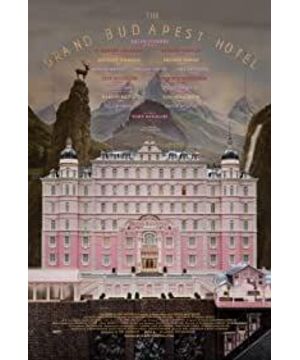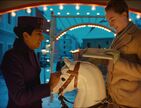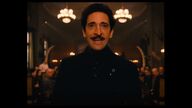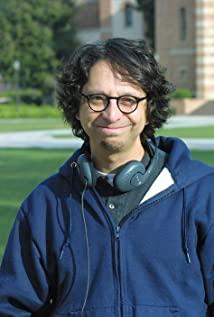When the director is shaping the image of the film, he will always use historical resources intentionally or unintentionally. "The tradition of ancestors is so entangled with reality." The profound timeliness constitutes the background color of the film, and the common memory of mankind is abundant. In view of its dimensions, it is worth mentioning that the effect of the imagery pieced together from the fragments of the historical background in the film is often automatically generated, and what the director does is often nothing more than a list of brocades.
There are many famous apples in history: one seduced Eve, one awakened Newton, one endorsed a world brand, and one became a world famous painting.
I believe viewers who have watched "The Grand Budapest Hotel" should remember this "Apple Boy" especially fresh.
According to the description of the film, this painting "boy with apple" was made by the painter Johannes van Hoytl, the younger. Gustav described it as:
The painting "Apple Boys" is priceless
Unspeakably beautiful
Even the most talented troubadour
Can't describe the beauty of one in ten million
Its tongue...
This is Van Huo’s most exquisite portrait
The protagonist is a beautiful man who is about to become an adult
Blond, smooth, skin-like fat
Impeccable background
Is the last and best private collection
This is a masterpiece
Everything else here is rubbish
I will never be separated from this painting
It reminds her of me
Will always remind me of her
I want to breathe under this painting
Can you see how similar we are
Let's do further analysis. The author believes that since these film images are compiled from historical fragments, they can be traced back to the source, deconstructed and restored step by step to specific and complete historical works and allusions, and in that historical context Next, I examine the meaning and color that the film statement may represent in the dual topic. Although sometimes this kind of connection is merely the wishful thinking of readers, the ubiquitous historical context makes any appropriate connection should be allowed, and many theorists have argued that readers have such self-justified second creation rights. . Therefore, we have the confidence to do some dismantling, tracing and trying to interpret the work below:
Apple boy
The realistic creator of this painting is British contemporary artist Michael Taylor, and the model he mimics is Ed Munro (Ed Munro). Regarding the specific details of the creation of this painting, "The Week "I did a detailed interview, and the quotes are as follows:
Michael: I was contacted by the producer at the beginning. Later, Wes called me personally and told me that he would send me some pictures. These pictures do not have a unified theme. Some of the contents are castles, old European restaurants, observation decks on high mountains, and of course a lot of Renaissance portraits of teenagers. This idea piqued my interest.
Ed: One weekend, I practiced dancing in the dance classroom in Covent Garden (London, England). We heard that a director is looking for a model, on condition that he is blonde and has the figure of a ballerina. We were not told the name of the director or any information about the film. I sent some of my photos to the agent in charge, and they told me the next day that the director liked those photos, and that I got the job! But at the time they only revealed that I would be a painting A model, and the painting will play a pivotal role in the movie.
Michael: Weiss provided a lot of references, especially the paintings of famous Renaissance masters such as Bronzino, Holbein, and Karanach. We chatted a lot of ideas through emails. Sometimes he would be very excited and say: "Yes, yes, yes! We must try this!" But sometimes "Why don't you try to change the color of the sleeves?" Sometimes his advice is very accurate Specific, but sometimes very extensive, and even contradictory. I didn't quite grasp what he wanted at first, until I realized that perhaps what he wanted was a painting that seemed to really exist, but it was in a parallel time and space.
Ed: Velvet cape, fur, corset, tights, leather shoes, crotch protector, I tried a lot of accessories, there are about fifty sets of matching. There is a corset that Kate Blanche wore in "Elizabeth: The Glory Age"! The costume designer will take all the sets of matching and pass it to Wes, and then he decides which one to use.
Michael: When I first received the drawing commission, I actually didn't know much about Wes. But now, this seems to be an advantage. In this way, I can draw my paintings without any prerequisites. Weiss's aesthetics is so contagious, it might be a good thing to give this painting its own unique style. I get along well with Ed. He fully meets the requirements of the character in the painting. We worked together in Dorset for a while.
Ed: There is a historic school near Michael's house. The Jacobean architecture and beautiful stone courtyard give it a classic atmosphere. Because it was the summer vacation, all the boarding school students went home. Only the principal and a few horses in the stable were left on the entire campus. Before working, Michael would play some Elizabethan-style music to help him get into his emotions.
Michael: In the first few months, Weiss gave me a lot of space to create, and I was doing this almost alone. However, as the shooting time got closer and closer, he began to discuss every aspect of the painting with me. Some meet his needs, but some are not up to the standard at all. Although I have a script in hand, I try not to inject too many script elements into my work. The pressure to make an invaluable treasure is indeed quite large, and I have also spent a lot of time on it. It took almost four months from the beginning of the drawing to the delivery of the finished product.
Ed: When I discovered in the trailer how important the role of the painting with my theme is, I was really happy! When I saw the finished product of "Apple Boys" for the first time two years ago, I thought it was similar to I don't look like it at all. But it's weird. Now that I have grown up, I have become more like the boy in the painting.
Michael: I think we finally finished a work that combines the ideas of me and Weiss. It looks familiar, but it is unique. Everything in the movie is delicate and interesting. More importantly, you can feel the faint sadness and depression through the director's ingenious arrangements, which seem to show up-this gives this movie its due weight.
I'm not sure where the original painting of "Apple Boys" is now in the world. One of the joys of painting is: you create, and then you let go, let your painstaking efforts to develop a journey on your own. After I finished it, I also made a beautiful cotton spreading box to prevent possible damage during transportation and shooting; I also stuck a "How to Take Care of Your Apple Boy" manual on the lid. That was the last time I saw the painting, until I entered the theater and saw it appear on the big screen again.
This "boy with apple" is indeed as reflected in the interview. It has a strong Elizabethan style, exquisite and meticulous without losing interest. You can also feel a kind of faint sadness and a touch of depression, which is bestowed on it. The weight of the whole movie is due. The author even suspects that the secret files hidden behind the painting are inspired by Michael’s "How to Take Care of Your Apple Youth" on the lid of the box. To some extent, the painter and the director work together. Created such a successful Macguffin.
As for the point of "not losing interest" he mentioned, I think it is well shown in the hand gesture of the boy holding the apple in the painting of "Apple Boy". The boy pinched the stalk of the apple with his thumb and index finger, and the other three fingers Slowly unfolding one by one, this dexterous movement gives the unskilled paintings a vivid aura——
Some netizens also analyzed that this painting is a combination of Raphael’s early "Young Man with Apple" and the French Renaissance Fontainebleau School’s "Sister Estre". The person seems to be in the palm shape of the gesture, which may indeed guess the work that Michael may learn from when creating, and the magical use and transplantation of the "pinch" gesture also makes the picture contain a clever joke. In this context, Apple has become The substitutes and metaphors of breasts are reminiscent of the themes of "forbidden fruit" and "desire". It has to be said that the artist's intentional or unintentional creation here creates a sense of humor that is clever and not vulgar.
But as shown in Michael’s own account, he also referred to the works of Bronchino, Dürer, and some portrait painters of the Dudd period.
I found this terribly confusing at first until I realized that each image contained some required element that had to be worked into the painting.He clearly knew exactly what he wanted; it was just that nothing quite like it yet existed. It was an irresistible challenge .
This narrative should be paid attention to. The first person who painted by Michael was Wes. He was very confused at the request of Wes at first, and Wes was a party A who had a clear request, "He wants one that does not exist. "Things", Weiss refused to send back his work again and again, and it was not until Michael combined specific elements from different paintings to enter "Apple Boy" in the painting that Weiss was finally satisfied. We can see that Weiss’s requirements for "Apple Boy" are "eclectic". He requires different elements to fully intervene in this painting to enrich its connotation. Therefore, "Apple Boy" is referred to as "Estre". "Sisters" and "The Young Man with Apple" are of course keen observations. This statement is partially correct but far from complete. "Apple Boy" draws on more classic European paintings and traditional styles. It is an old and new one. The miscellaneous stuff.
It should be said that Wes is looking for the right person when looking for Michael. From the three paintings displayed here, it can be fully seen that Michael’s style is a kind of eclectic mix and match. There is a traditional Renaissance portrait canvas scene. With the super-realistic style of modernism and the ritual sense of medieval painting, weaving a dense and complex texture, especially the faces of the characters, flowing with the pathological colors like those in Bacon’s works, it is easy to learn from " This is experienced in "Apple Boys".
Let’s look at another piece of Bronzino’s “Portrait of a Girl”. She has a peaceful face, clear eyes and golden hair. The luxurious and low-key clothing exudes elegance and innocence, as if she can give a glimpse of the Italian aristocratic style of the Renaissance. In life, this painting is a typical Renaissance portrait, and it can be said to be somewhat similar to "Apple Boy".
Therefore, for the eclectic work "Apple Boy", it is difficult to say which two paintings it is made of. It can be the epitome of the cut fragments of all the paintings, or it can be nothing, but it seems certain. One point is that the director Weiss wants to take some specific meaning from this absurd compromise. Perhaps it is to use it as an overall symbol of old European tradition and civilization. Just like it, "Apple Boy" is graceful and luxurious, refined and elegant. The background is impeccable and "is the last and best private collection".
Many articles have stated that Gustav paid tribute to Zweig, and I deeply say that, and as he proclaimed in "Yesterday’s World", "the end of the era", that traditional European will last forever The elegance and order never returned. As a symbol of the dead world, "Apple Boy" was stolen, hidden in snow, and almost betrayed on the black market. Finally, it was sealed in the Budapest Grand Hotel as a remembrance of the world and the castle of illusions. It was replaced by another painting (called trash by him) that Gustav picked up everywhere-
As an important representative of the Viennese Secessionist, Schiller's appearance here seems to be unsurprising (Nu Mao country is probably the part of the Austro-Hungarian Empire). The slender, exaggerated and strong sense of ups and downs have been transformed into a form of three-dimensional deconstruction. The captured, undisguised pornographic images give people anxiety and depression as a whole, the mind and body are almost split apart, and the ubiquitous sense of prance gives people a kind of vitality.
This fake replacement of "Apple Boys" is still eclectic. It makes a vulgar joke between Schiller and his teacher's work "The Kiss"-it uses Schiller's lines and colors, but uses The action in Klimt's "Kiss" by Schiller teacher, but the holy love between the opposite sex is replaced by the sensuality between the same sex, and the pious kneeling woman becomes a woman who spreads her legs and waits for caress. Klimt's strong sadness in "The Kiss" is dispelled by the superficial theme of sex, and replaced by a complete indulgence of flesh and animal desires.
This kind of replacement is fascinating. How far is the distance from the traditional European portraits to the Vienna School of Secession, and what does Weiss see between the opposites at this distance? Was it the latter’s claim that it “will break with traditional aesthetics and part ways with orthodox academic art”? This seems to be something to talk about, but more topics are worth exploring.
One thing seems to be certain. The replacement of these two paintings can be said to symbolize a certain change in European civilization-she did not die and disintegrate as Zweig predicted-the aristocratic spirit of Yijiao Temple has declined. , Representing classics and traditional art collections have been lost, barren breasts have replaced the green apples, eternal grace and conservatism have been replaced by the overflowing and indulgent desires, romantic poetry of love and beauty in the sexual intercourse of animal desires No one hears, groaning and wheezing become necessary to numb oneself in mental pain, to fuck the graceful and luxurious, refined and elegant traditional Europe is dead, just like the dark and gloomy background of "Apple Boy" and the scars on the apple that are no longer young In general, the signs of aging are full of everything related to the youth in the blooming season. Here are Weiss’s wishful thinking about the golden age of the past, as well as a sharp criticism of the current superficial materialistic capital society.
Ai Xiaoke’s film review pointed out: "The Budapest Hotel is a postcard sent to old Europe." Then we might as well say that the authenticity of the two "Apple Boys" are two portraits of European spirit. The painting extends an endless long road, one end leads to redemption, the other end leads to destruction, intertwined with each other, without a trace, where to go, where to go?
View more about The Grand Budapest Hotel reviews











